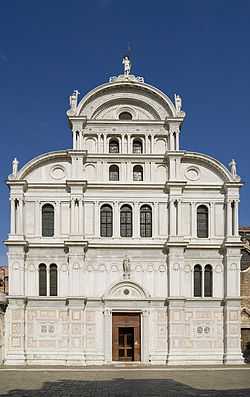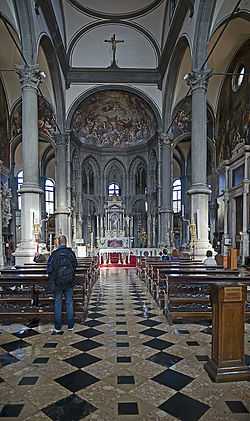San Zaccaria, Venice

San Zaccaria is a church in Venice, northern Italy, dedicated to Saint Zechariah, although his cult is often superimposed with that of the father of John the Baptist, whose body it conserves, under the second altar on the right. It is a large edifice, located in the quiet Campo San Zaccaria, just off the waterfront to the south east of St. Mark's basilica.

.jpg)
The present church was built between 1458 and 1515. Antonio Gambello was the original architect, who started the building in the Gothic style, but the upper part of the facade with its arched windows and its columns, and the upper parts of the interior were completed by Mauro Codussi in early Renaissance style seventy years later. The facade is a harmonious Venetian mixture of late-Gothic and Renaissance styles.
The first church on the site was founded by Doge Giustiniano Participazio in the 9th century and eight doges are buried in the crypt. The original church was rebuilt in the 1170s (when the present campanile was built) and was replaced by a Gothic church in the 15th century. The remains of this building still stand, as the present church was built beside and not over it.
The church was attached to a female Benedictine monastery, which was visited by the doge and the whole signoria annually at Easter in a ceremony which included presentation of the cornu (ducal cap), insignia of his dignity. This tradition is said to have begun after the monks donated land for the building of the St Mark's Basilica in the 12th century and ended in 1797 at the end of the republic. The nuns of this monastery mostly came from prominent noble families and had a rebellious reputation. The abbess was usually related to the doge.
The interior of the church has an apse surrounded by an ambulatory lit by tall Gothic windows, a typical feature of Northern European church architecture which is unique in Venice. Nearly every wall is covered with paintings by 17th and 18th century artists. The church houses one of the most famous work by Giovanni Bellini, the San Zaccaria Altarpiece. The walls of the aisles and of the chapels host paintings by other artists including Andrea del Castagno, Palma Vecchio, Tintoretto, Giuseppe Porta, Palma il Giovane, Antonio Vassilacchi, Anthony van Dyck, Andrea Celesti, Antonio Zanchi, Antonio Balestra, Angelo Trevisani and Giovanni Domenico Tiepolo.
The artist Alessandro Vittoria is buried in the church, his tomb marked by a self-portrait bust.
The church was particularly famous for his collection of relics, among which are those of Athanasius of Alexandria and a piece of the True Cross.
External links
- Satellite image from Google Maps
- Adrian Fletcher's Paradoxplace Venice Pages – San Zaccaria (photos)
Coordinates: 45°26′05″N 12°20′36″E / 45.43472°N 12.34333°E
.jpg)